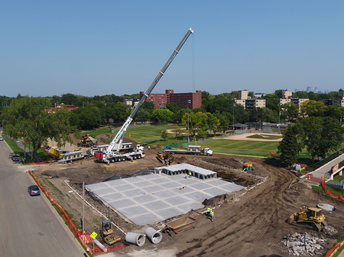
The City of St. Louis Park’s stormwater program is engaging other city departments and residents on proper stormwater management. City
staff recently answered a few of our questions about how they’ve been successful
in integrating stormwater management into city programs and getting residents
invested in reducing stormwater pollution.
Q: St.
Louis Park has figured out some innovative ways to incorporate stormwater
management into other aspects of city work. Tell us about that.
A: The City of St. Louis Park is particularly proud of three
recently completed projects that incorporated stormwater management as part of
planned city work and private development.
-
Carpenter Park Regional Stormwater Improvement Project is a
large underground water management system that provides treatment to more than
40 acres in a city park. It also provides mitigation credits to a nearby
proposed redevelopment associated with Southwest Light Rail Transit, where
existing site conditions would have made it challenging to provide the required
treatment. Finally, it provides a solid foundation for the city’s new outdoor
skate park and improves drainage on nearby athletic fields.
- The city’s 2017 pavement management project included a 5% reduction in hard surfaces, and multiple tree
trenches and pervious pavement in an existing parking lot.
-
The city helped facilitate a building and parking lot expansion
for Japs-Olson, which required a land swap with a neighboring city. The
result was stormwater treatment to more than 20 acres of
impervious area immediately adjacent to Minnehaha Creek.
Q: What benefits have you seen from these projects?
A: We
work hard to address smaller drainage and erosion issues, where
residents and businesses realize project benefits relatively quickly. The
public sees these smaller projects and how they help and that can raise
awareness to the benefits of the larger regional projects. Ultimately, it’s
important that the city walks the walk and that we include stormwater
management into routine city projects, just as we are asking residents and
businesses to be mindful of stormwater in their practices.
Q: Did
you face any hurdles or barriers while integrating stormwater management into
city projects?
A: One
of our biggest hurdles is getting people engaged and involved in stormwater
management. This becomes even more challenging in a community without its own
major lake or waterfront properties. Whether it’s attending a meeting about
stormwater or simply using less salt on their driveways in the winter, we
continue to work on creative ways to reach people and to spread the message
that stormwater matters.
Q: You’ve
also found ways to incentivize residential stormwater management. Tell
us about your Rainwater Rewards program.
A: Developed
in 2017, the Rainwater Rewards Program is designed to help residents understand
the importance of stormwater. The program provides up to $3,000 in funding to residents who are willing to take steps to reduce
stormwater runoff from their property. The program has been well received by residents, which is great news considering the city only controls
about 30% of the land in St. Louis Park. We need community participation
in order to reach our stormwater management goals!
Q: Have
you had any challenges engaging residents to be proactive about stormwater
management?
A: The
city provides a variety of environmental initiatives and programs. We’ve found
success by collaborating with other city departments and community events to
provide outreach to residents and businesses that might not normally be
interested. We focus on clear messaging, so that people can easily learn about
and put stormwater management into practice.
|